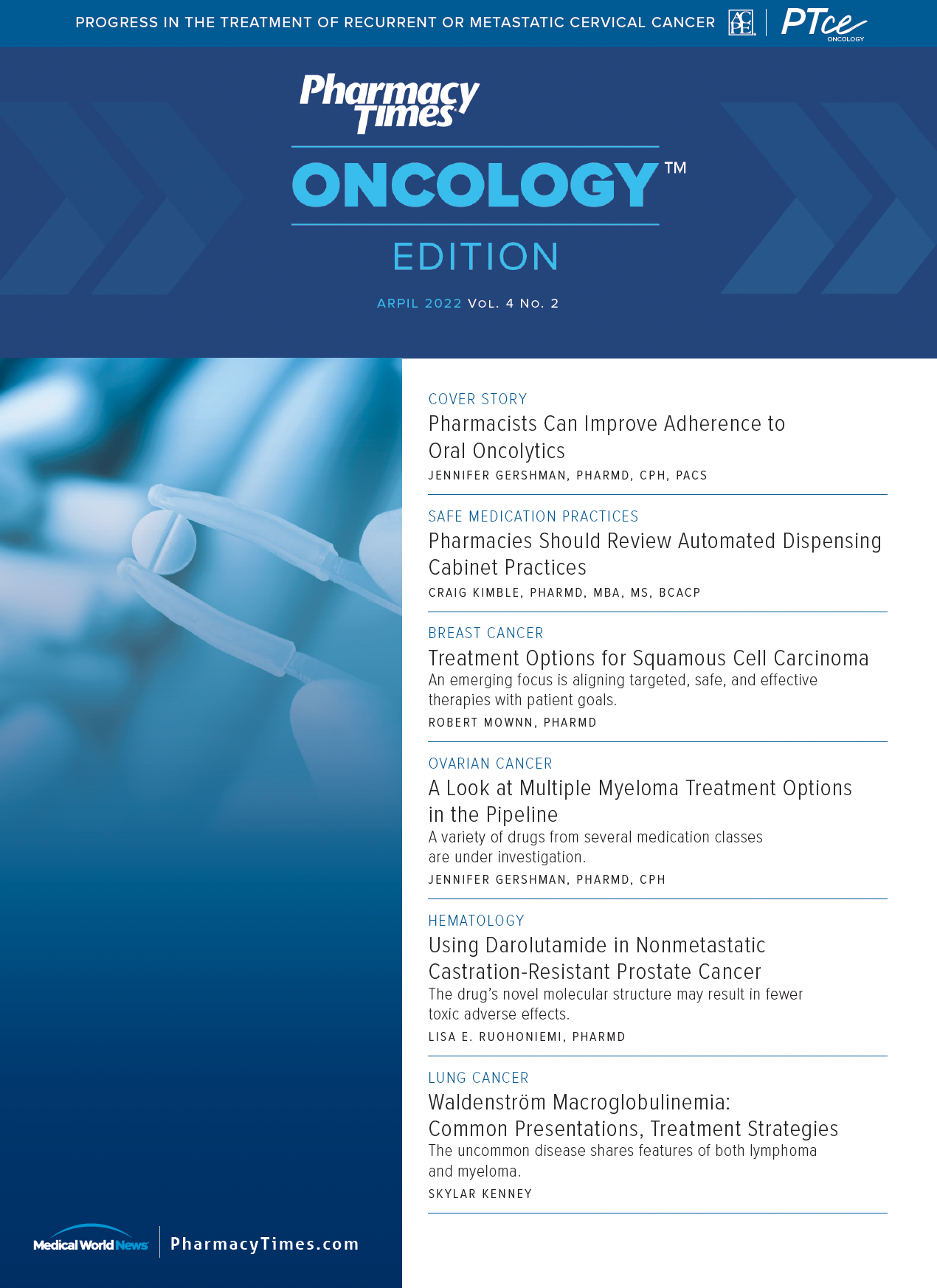Publication
Article
Pharmacy Practice in Focus: Oncology
Treatment Options for Squamous Cell Carcinoma
Author(s):
Cutaneous squamous cell carcinoma should be diagnosed early and treated promptly to avoid complications.
Squamous Cell Carcinoma (SCC) of the skin tissue is a common cancer that develops in the skin’s squamous cells, which are concentrated in the middle and outer layers of the skin tissue.1 Although this type of cancer is typically not life-threatening, it can spread to other parts of the body and cause various complications.
SCC can develop because of prolonged exposure to UV light and radiation, either naturally or from tanning beds. It is the second most common skin cancer in the United States, with about 1.8 million cases diagnosed in the United States each year. However, 95% of SCC cases of the skin can be detected early and are curable, with a history of medical research investigating potential treatments tracing to the 18th century.1
This disease is also known as cutaneous squamous cell carcinoma (CSCC), which identifies SCC of the skin compared with SCCs in other areas of the body, such as the mouth, throat, lungs, and genital regions.2 Symptoms of CSCC can include a red nodule, flat sore, raised sore on an old scar, rough scaly patch, red sore in the mouth, or red raised patch or wartlike sore on the anus or genitals.1
Diagnosis of CSCC can be done with a biopsy and removal of the sample tissue for confirmation. Nonpharmaceutical treatment options for small SCC cancers may include curettage and electrodesiccation, laser therapy, freezing, or photodynamic therapy. Treatments for CSCC in larger areas may include removal of the affected area, Mohs surgery, or radiation therapy.1
Medications approved for SCC include cemiplimab (Libtayo; Regeneron and Sanofi) and pembrolizumab (Keytruda; Merck). If the cancer has metastasized, other options could include cisplatin (Platinol; Bristol Myers Squibb), doxorubicin (Lipodox; Sun Pharma), or bleomycin (Blenoxane; Bristol Myers Squibb), as well as 5-fluorouracil. These drugs have all demonstrated some degree of efficacy.3
Treatment of SCC with cemiplimab may include 350 mg given intravenously over 30 minutes every 3 weeks until disease progression or unacceptable toxicity. This drug is an immunoglobulin G4 monoclonal antibody that binds to the human programmed death receptor-1 (PD-1) and blocks the interaction with PD-1 ligands 1 and 2. This process works by stopping T-cell proliferation and cytokine production, which produces the antitumor response.4
Pembrolizumab dosing for the treatment of SCC is 200 mg intravenously over 30 minutes every 3 weeks or 400 mg intravenously over 30 minutes every 6 weeks until disease progression stops, unacceptable toxicity, or up to 24 months of therapy. This drug is a monoclonal antibody that acts as
an immune checkpoint inhibitor, binding to PD-1 receptors on T cells and blocking the PD-1 interaction with PD-1 ligands.5
Cisplatin is given at a dose of 100 mg/m2 every week or for 3 weeks. Reaching the cumulative dose of cisplatin in the body has not been shown to improve clinical outcomes for SCC.6 Furthermore, 5-fluorouracil is used both topically and intralesionally and has shown improved outcomes in SCC. Studies have shown that 8 weekly injections of 0.8 mL to 2.4 mL help with total clearance of the cancer.7
Doxorubicin dosing for SCC may include 40 mg/m2 to 60 mg/m2 intravenously every 21 to 28 days.8 This drug has antimitotic and cytotoxic activity toward the cancerous cells by stabilizing the DNA-topoisomerase II complex, preventing the cancer from spreading.8
Although SCC is typically not life-threatening, treating it early and promptly is crucial. With the currently available treatment options and strategies, the prognosis for patients with an SCC diagnosis is brighter than ever.
References
1. Squamous cell carcinoma of the skin. Mayo Clinic. May 13, 2021. Accessed July 8, 2021. https://www.mayoclinic.org/diseases-conditions/squamous-cell-carcinoma/symptoms-causes/syc-20352480
2. Advanced squamous cell carcinoma treatment. Skin Cancer Foundation. Updated February 2020. Accessed July 8, 2021. https://www.skincancer.org/ skin-cancer-information/squamous-cell-carcinoma/advanced-scc/
3. DeConti, RC. Chemotherapy of squamous cell carcinoma of the skin. Semin Oncol. 2012;39(2):145-149. doi:10.1053/j.seminoncol.2012.01.002
4. Libtayo. Prescribing information. Regeneron Pharmaceuticals; 2021. Accessed July 8, 2021. https://www.regeneron.com/downloads/libtayo_fpi.pdf
5. Keytruda. Prescribing information. Merck; 2021. Accessed July 8, 2021. https:// www.merck.com/product/usa/pi_circulars/k/keytruda/keytruda_pi.pdf
6. Helfenstein S, Riesterer O, Meier UR, et al. 3-weekly or weekly cisplatin concur- rently with radiotherapy for patients with squamous cell carcinoma of the head and neck—a multicenter, retrospective analysis. Radiat Oncol. 2019;14(1):32. doi:10.1186/ s13014-019-1235-y
7. Morse LG, Kendrick C, Hooper D, Ward H, Parry E. Treatment of squamous cell carcinoma with intralesional 5-fluorouracil. Dermatol Surg. 2003;29(11):1150-1153. doi:10.1046/j.1524-4725.2003.29355.x
8. Doxorubicin. RxList. Accessed July 8, 2021. https://www.rxlist.com/consumer_ doxorubicin_adriamycin/drugs-condition.htm







